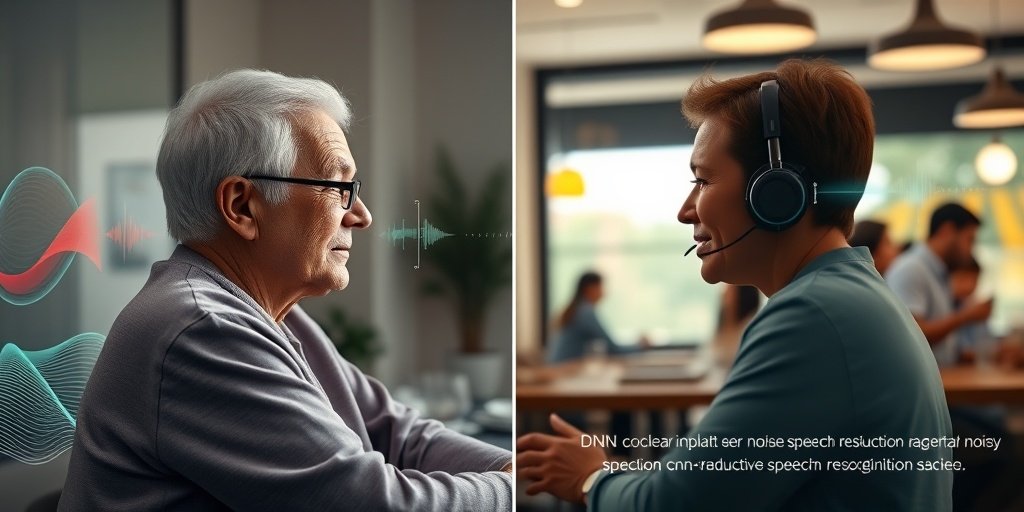⚡ Quick Summary
A recent study demonstrated that DNN-based noise reduction significantly enhances speech understanding in noisy environments for bimodal cochlear implant (CI) users. The results showed an impressive 19% average improvement in sentence recognition scores, highlighting the potential of this technology in improving communication for individuals with hearing challenges. 🎧
🔍 Key Details
- 👥 Participants: 11 bimodal CI patients aged 71-89 years
- 🔊 Hearing Aids: Phonak Audéo Sphere Infinio 90
- ⚙️ Technology: DNN-based noise reduction programs (Calm Situation and Spheric Speech in Loud Noise)
- 📊 Measurement: Sentence recognition scores using AzBio sentences
🔑 Key Takeaways
- 📈 Significant Improvement: DNN program improved bimodal performance in noise by 19%.
- 🔊 Enhanced Recognition: Sentence recognition scores reached 79% with DNN compared to 60% with Calm Situation.
- 🌪️ Multi-talker Babble: DNN HA program provided a 40% bimodal benefit versus 21% with Calm Situation.
- 💡 Breakthrough Technology: DNN-based noise reduction offers a promising solution for speech understanding in noise.
- 👵 Age Range: Participants were older adults, emphasizing the need for effective solutions in this demographic.
- 🧠 Cognitive Load: Improved speech perception can reduce cognitive strain in challenging listening environments.
- 🏥 Clinical Relevance: Findings support the integration of advanced noise reduction technologies in clinical practice.

📚 Background
Traditional hearing aids often struggle to provide adequate noise reduction for bimodal cochlear implant users, who rely on both a CI and a hearing aid for optimal hearing. This study addresses a common challenge faced by these individuals: understanding speech in noisy environments. With advancements in deep neural networks (DNN), there is potential for significant improvements in auditory experiences for users of hearing devices.
🗒️ Study
The study involved 11 bimodal CI patients who were fitted with a Phonak Audéo Sphere Infinio 90 hearing aid. They were tested using two DNN-based noise reduction programs: Calm Situation and Spheric Speech in Loud Noise. The researchers measured sentence recognition scores in both quiet and noisy settings to evaluate the effectiveness of the DNN technology.
📈 Results
The results were striking: the DNN program significantly improved sentence recognition scores in noise, achieving 79% compared to 60% with the Calm Situation program (p < 0.001). Additionally, in challenging multi-talker babble conditions, the DNN program provided a 40% bimodal benefit, far exceeding the 21% score from the Calm Situation program. These findings underscore the effectiveness of DNN-based noise reduction in enhancing speech understanding for bimodal CI users.
🌍 Impact and Implications
The implications of this study are profound. By integrating DNN-based noise reduction technologies into hearing aids, we can significantly improve the quality of life for bimodal CI users. This advancement not only addresses a common complaint regarding speech understanding in noise but also opens the door for further innovations in auditory technology. The potential for broader applications in various auditory environments is exciting and could lead to enhanced communication for many individuals with hearing impairments.
🔮 Conclusion
This study highlights the remarkable potential of DNN-based noise reduction in transforming the auditory experiences of bimodal cochlear implant users. With a significant improvement in speech understanding in noisy environments, this technology represents a promising advancement in hearing aid design. Continued research and development in this area could lead to even greater enhancements in communication for those with hearing challenges. Let’s embrace these innovations for a better auditory future! 🌟
💬 Your comments
What are your thoughts on the impact of DNN technology in hearing aids? We would love to hear your insights! 💬 Share your comments below or connect with us on social media:
DNN-Based Noise Reduction Significantly Improves Bimodal Benefit in Background Noise for Cochlear Implant Users.
Abstract
Background/Objectives: Traditional hearing aid noise reduction algorithms offer no additional benefit in noisy situations for bimodal cochlear implant (CI) users with a CI in one ear and a hearing aid (HA) in the other. Recent breakthroughs in deep neural network (DNN)-based noise reduction have improved speech understanding for hearing aid users in noisy environments. These advancements could also boost speech perception in noise for bimodal CI users. This study investigated the effectiveness of DNN-based noise reduction in the HAs used by bimodal CI patients. Methods: Eleven bimodal CI patients, aged 71-89 years old, were fit with a Phonak Audéo Sphere Infinio 90 HA in their non-implanted ear and were provided with a Calm Situation program and Spheric Speech in Loud Noise program that uses DNN-based noise reduction. Sentence recognition scores were measured using AzBio sentences in quiet and in noise with the CI alone, hearing aid alone, and bimodally with both the Calm Situation and DNN HA programs. Results: The DNN program in the hearing aid significantly improved bimodal performance in noise, with sentence recognition scores reaching 79% compared to 60% with Calm Situation (a 19% average benefit, p < 0.001). When compared to the CI-alone condition in multi-talker babble, the DNN HA program offered a 40% bimodal benefit, significantly higher than the 21% score seen with the Calm Situation program. Conclusions: DNN-based noise reduction in HA significantly improves speech understanding in noise for bimodal CI users. Utilization of this technology is a promising option to address patients’ common complaint of speech understanding in noise.
Author: [‘Kolberg C’, ‘Holbert SO’, ‘Bogle JM’, ‘Saoji AA’]
Journal: J Clin Med
Citation: Kolberg C, et al. DNN-Based Noise Reduction Significantly Improves Bimodal Benefit in Background Noise for Cochlear Implant Users. DNN-Based Noise Reduction Significantly Improves Bimodal Benefit in Background Noise for Cochlear Implant Users. 2025; 14:(unknown pages). doi: 10.3390/jcm14155302